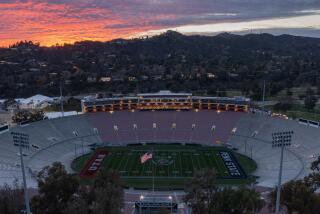Rural by the Rose Bowl
Since Pasadenaâs founding, the city has evolved from a tiny colony of health seekers into a well-known and highly developed part of greater Los Angeles. Yet as the townâs center has urbanized, a small neighborhood west of the Rose Bowl has fought for more than a century to maintain its rural character.
Beginnings
In the 1880s, John Muir would stroll across the Arroyo Seco to enjoy the wildflowers that grew on these hillsides.
He wasnât the only one. To many of the Midwestern families who founded Linda Vista as a farming village, this was paradise.
When Pasadena annexed the region in 1914, Linda Vista was a conservative rural hamlet, largely cut off from the city around it. Children under 18 needed a signed permit to stay out past 9 p.m. Residentsâ main priority was the construction of an easy route south to Colorado Boulevard, which was finally built a decade later.
By 1950, Linda Vista had become more developed but remained peaceful, removed but not isolated. It still is today.
What itâs about
âItâs the trees,â said Scott Kleiman, a Sothebyâs International Realtor who lives in Linda Vista and has sold many houses here. Driving home through the neighborhoodâs sycamore and oak-lined streets reminds Kleiman of his childhood in Evanston, Ill.
Though it seems a strange sentiment in the heart of semi- arid Southern California, Kleimanâs feelings are echoed by others in the area. Linda Vistaâs all-American look and strong sense of community, unchanged for decades, remind many residents of the era in which they grew up.
A strong voluntary-membership neighborhood association counts almost half the areaâs residents as members. Through projects such as protecting the neighborhoodâs ornamental lighting and fighting a proposed Pasadena marathon that would temporarily close Linda Vista Avenue -- in addition to its never-ending conflict with Rose Bowl management over traffic and noise issues -- the association works to keep the streets here as residential as they were in the 1950s. And it does a pretty good job.
Insiderâs view
Betsy Nathane bought a small, decrepit cottage in Linda Vista in 1989.
Her husband, a professional home builder, spent almost two years tearing it down and replacing it with a four-bedroom, contemporary wooden house with a big porch and views of the San Gabriel Mountains. Now the couple, who have a teenage son, have occupied the home for more than 16 years.
âItâs like living in a park,â Nathane said.
âWe have deer that walk down our side driveway every night . . . and an owl that hangs around in our tree.â She added that the street has played host to bobcats, coyotes, skunks and red-tailed hawks.
The couple made friends through their sonâs carpool, the neighborhood association and monthly, potluck-style barbecues on their street. Walking the dog on nearby nature trails also helped. âYou meet people there all the time,â Nathane said. Now, she jogs around the Rose Bowl several times a week with some friends from the neighborhood.
In addition to the popular walking and cycling routes around it, the Rose Bowl provides a spectacular annual fireworks show thatâs visible from nearby homes. âUsually everyone in the neighborhood has a Fourth of July party,â Nathane said.
The family can watch from their porch or stroll down to the rim of the Arroyo, where half the neighborhood turns out to see the display.
Housing stock
Linda Vista contains only about 1,300 homes, but itâs not too hard to find one for sale. Last year, 54 properties changed hands in the neighborhood, and sales for 2007 are on track to exceed that.
Current offerings include a two-bedroom, 1,477-square-foot traditional-style home on Linda Vista Avenue listed at $999,000. A three-bedroom, 3,436-square-foot home with panoramic views in the hills near La CaĂąada Flintridge is on the market for $1,685,000.
Good news, bad news
Although Linda Vistaâs proximity to the Rose Bowl is a blessing for most of the year, come football season every road into the neighborhood clogs faster than you can say âGo, Bruins.â If an NFL team ever makes the bowl its home -- a concept the neighborhood association has fought vigorously -- the situation will only get worse.
Report card
Linda Vista is part of the Pasadena Unified School District. Students through fifth grade attend San Rafael Elementary, which scored 691 out of a possible 1,000 on the 2006 Academic Performance Index Base Report. They move on to Charles W. Eliot Middle School and Muir High School, which scored 677 and 601, respectively. Many neighborhood children attend private schools.
Sources: Scott Kleiman, Sothebyâs International Realty, scott.kleiman@sothebysrealty .com; api.cde.ca.gov.
More to Read
Sign up for Essential California
The most important California stories and recommendations in your inbox every morning.
You may occasionally receive promotional content from the Los Angeles Times.










